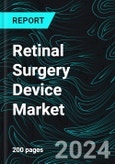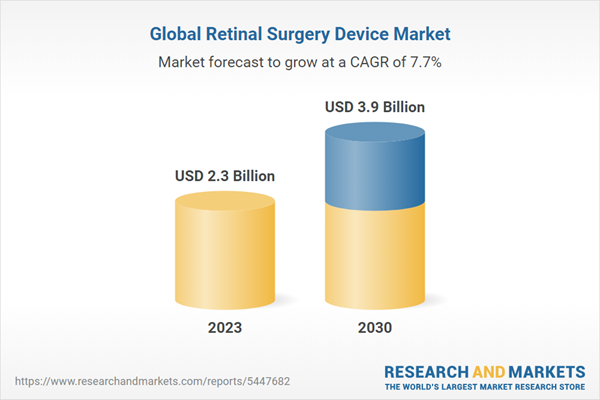Globally, an anticipated 196 million people aged 50 and older are living with age-associated macular degeneration (AMD), according to the NCBI. With a growing old population, extending diabetes rates, and stepped-forward diagnostics, retinal illnesses like AMD and diabetic retinopathy have become increasingly prevalent. This surge in diagnoses underscores the developing necessity for retinal surgical operation interventions. Moreover, the scope of retinal surgical treatment devices has expanded beyond treating AMD and diabetic retinopathy, leading to advancements in the field.
Global Retinal Surgical Device Market is anticipated to experience a CAGR of 7.71% between 2024 and 2030
Retinal surgical devices now cater to a broader range of conditions beyond AMD and diabetic retinopathy, including retinal detachment, tears, and macular holes. Despite their initial costs, these devices are cost-effective in the long term because of their minimally invasive nature, resulting in shorter hospital stays, quicker recovery, and decreased healthcare expenses. This affordability renders them a sustainable option for healthcare structures. Moreover, the rising trend closer to personalized medication also affects the retinal surgery device market, as surgeons leverage genetic testing and other diagnostic equipment to tailor strategies to individual patients, ultimately enhancing treatment consequences.The global retinal surgical device market expects significant growth, propelled by technological advancements. Vitrectomy machines are essential for removing blood or debris from the vitreous gel in the eye. They improve the function of dual-port structures and microincision vitrectomy, allowing for better maneuverability and quicker recovery. Precision contraptions, including delicate needles and forceps, permit correct manipulation of retinal tissues. High-resolution microscopes are used to visualize retinal structures with the help of microscopic illumination equipment. Retinal laser devices have evolved with improved precision for tactics like diabetic retinopathy treatment. Diagnostic equipment like optical coherence tomography (OCT) structures provides designated retinal images, essential for surgical planning and post-operative assessment. So, the global retinal surgical device market is valued at around US$ 2.3 Billion in 2023.
Asia Pacific is projected to experience prompt market growth due to increasing healthcare infrastructure, awareness, expenditure, and adoption of new devices and treatment options. Government dedication to enhancing access to retinal surgical procedure gadgets in the Asia-Pacific continues to gather momentum. The launch of the "Vision 2030" initiative aims to improve eye care infrastructure and provide affordable retinal surgery devices for a wider population. The "Advanced Retinal Technology Mission" expansion seeks to enhance and commercialize affordable retinal gadgets, explicitly focusing on cellular ophthalmic devices for underserved communities.
Vitrectomy machines are vital in the retinal surgery device market because they treat diverse retinal conditions
By products, the global retinal surgery device market is segmented into Vitrectomy Machines, Vitrectomy Packs, Surgical Instruments, Microscopic Illumination Equipment, Retinal Laser Equipment, and Others. Vitrectomy machines represented the largest segment. These machines facilitate the elimination of vitreous gel debris or blood during surgical operations, addressing situations such as retinal detachment, diabetic retinopathy, and macular holes. Their superior functions, combined with dual-port systems and microincision technology, enhance maneuverability and expedite recovery. This makes vitrectomy machines indispensable for retinal surgeons to deliver effective remedies and improve patient outcomes.The diabetic retinopathy phase is experiencing a significant boom in the retinal surgery device market due to the rising incidence of diabetes internationally
By application, the global retinal surgery device market is fragmented into Diabetic Retinopathy, Retinal Detachment, Epiretinal Membrane, Macular Hole, and Others. The International Diabetes Federation (IDF) predicts that 463 million adults aged 20-79 will have diabetes. By 2045, it'll rise to 700 million, and 79% will be from low- and middle-income countries. As diabetes rates increase, so does the occurrence of diabetic retinopathy, a common hardship that could cause imaginative and prescient impairment or blindness if left untreated. Consequently, there is a growing demand for retinal surgical devices, including vitrectomy machines, to control diabetic retinopathy effectively, propelling the growth of this section in the market.Hospitals dominate the retinal surgery device market because they are the primary facilities for surgical techniques and patient care
By end-users, the global retinal surgery device market is categorized into Hospitals, Eye Clinics, and Others. Hospitals accounted for a considerable market share. Equipped with superior facilities and specialized understanding, hospitals provide a comprehensive variety of retinal surgery devices, which include diagnostics, surgical interventions, and post-operative care. Hospitals also offer a conducive environment for surgeons to utilize cutting-edge retinal surgical treatment devices successfully, ensuring the most remarkable patient outcomes. Their vital function in healthcare devices solidifies hospitals as critical players in the retinal surgery device market.North America asserts dominance in the retinal surgery device market
By countries, the global retinal surgery device market is divided into North America (United States, Canada), Europe (France, Germany, Italy, Spain, United Kingdom, Belgium, Netherlands, Turkey), Asia Pacific (China, Japan, India, Australia, South Korea, Thailand, Malaysia, Indonesia, New Zealand), Latin America (Brazil, Mexico, Argentina), Middle East & Africa (South Africa, Saudi Arabia, and UAE). North America is anticipated to hold an essential share in the retinal surgery devices market. According to the CDC, over 12 million people in the US aged 40 and above have vision impairment, with 1 million being blind, 3 million having correctable vision impairment, and 8 million having vision impairment due to uncorrected errors. This has resulted in an increased demand for retinal surgeries. The area boasts advanced healthcare infrastructure, contemporary technology, and an excessive incidence of retinal illnesses. Moreover, intense research and improvement projects and significant investments in healthcare contribute to the fast adoption of revolutionary retinal surgery devices. Also, favorable compensation rules and the presence of leading market players similarly consolidate the United States' position as a frontrunner in driving advancements and growth in the retinal surgery device market.Key Players
Companies such as Topcon Corporation, Alcon AG, Carl Zeiss, Bausch Health Companies Inc., Iridex Corporation, Escalon Medicals, Quantel Medical, and Rhein Medical, Inc. are well-known in the retinal surgery device market.In January 2022 - Alcon obtained Ivantis, a company that develops and manufactures a minimally-invasive glaucoma surgery device called the Hydrus micro stent.
In April 2022 - Nova Eye Medical launched its next-generation canaloplasty device, the iTrack Advance, in selected European and Asian markets.
The report titled “Global Retinal Surgery Device Market By Product (Vitrectomy Machines, Vitrectomy Packs, Surgical Instruments, Microscopic Illumination Equipment, Retinal Laser Equipment, and Others), Application (Diabetic Retinopathy, Retinal Detachment, Epiretinal Membrane, Macular Hole, and Others),End-Users (Hospitals, Eye Clinics, and Others), Countries (North America (United States, Canada), Europe (France, Germany, Italy, Spain, United Kingdom, Belgium, Netherland, Turkey), Asia Pacific (China, Japan, India, South Korea, Thailand, Malaysia, Indonesia, Australia, New Zealand), Latin America (Brazil, Mexico, Argentina), Middle East & Africa (Saudi Arabia, UAE, and South Africa)), Company Analysis (Topcon Corporation, Alcon AG, Carl Zeiss, Bausch Health Companies Inc, Iridex Corporation, Escalon Medicals, Quantel Medical, and Rhein Medical, Inc)” provides a complete study of Global Retinal Surgery Device Industry.
Product - Global Retinal Surgery Device Market breakup in 6 viewpoints:
1. Vitrectomy Machines2. Vitrectomy Packs
3. Surgical Instruments
4. Microscopic Illumination Equipment
5. Retinal Laser Equipment
6. Others
Application - Global Retinal Surgery Device Market breakup in 5 viewpoints:
1. Diabetic Retinopathy2. Retinal Detachment
3. Epiretinal Membrane
4. Macular Hole
5. Others
End-Users - Global Retinal Surgery Device Market breakup in 3 viewpoints:
1. Hospitals2. Eye Clinics
3. Others
Countries - Global Retinal Surgery Device Market breakup in 5 viewpoints:
1. North America1.1 United States
1.2 Canada
2. Europe
2.1 France
2.2 Germany
2.3 Italy
2.4 Spain
2.5 United Kingdom
2.6 Belgium
2.7 Netherland
2.8 Turkey
3. Asia Pacific
3.1 China
3.2 Japan
3.3 India
3.4 South Korea
3.5 Thailand
3.6 Malaysia
3.7 Indonesia
3.8 Australia
3.9 New Zealand
4. Latin America
4.1 Brazil
4.2 Mexico
4.3 Argentina
5. Middle East & Africa
5.1 Saudi Arabia
5.2 UAE
5.3 South Africa
All the Key players have been covered from 3 Viewpoints:
- Overview
- Recent Development
- Revenue Analysis
Company Analysis:
1. Topcon Corporation2. Alcon AG
3. Carl Zeiss
4. Bausch Health Companies Inc
5. Iridex Corporation
6. Escalon Medicals
7. Quantel Medical
8. Rhein Medical, Inc
Table of Contents
Companies Mentioned
- Topcon Corporation
- Alcon AG
- Carl Zeiss
- Bausch Health Companies Inc
- Iridex Corporation
- Escalon Medicals
- Quantel Medical
- Rhein Medical, Inc
Methodology
In this report, for analyzing the future trends for the studied market during the forecast period, the publisher has incorporated rigorous statistical and econometric methods, further scrutinized by secondary, primary sources and by in-house experts, supported through their extensive data intelligence repository. The market is studied holistically from both demand and supply-side perspectives. This is carried out to analyze both end-user and producer behavior patterns, in the review period, which affects price, demand and consumption trends. As the study demands to analyze the long-term nature of the market, the identification of factors influencing the market is based on the fundamentality of the study market.
Through secondary and primary researches, which largely include interviews with industry participants, reliable statistics, and regional intelligence, are identified and are transformed to quantitative data through data extraction, and further applied for inferential purposes. The publisher's in-house industry experts play an instrumental role in designing analytic tools and models, tailored to the requirements of a particular industry segment. These analytical tools and models sanitize the data & statistics and enhance the accuracy of their recommendations and advice.
Primary Research
The primary purpose of this phase is to extract qualitative information regarding the market from the key industry leaders. The primary research efforts include reaching out to participants through mail, tele-conversations, referrals, professional networks, and face-to-face interactions. The publisher also established professional corporate relations with various companies that allow us greater flexibility for reaching out to industry participants and commentators for interviews and discussions, fulfilling the following functions:
- Validates and improves the data quality and strengthens research proceeds
- Further develop the analyst team’s market understanding and expertise
- Supplies authentic information about market size, share, growth, and forecast
The researcher's primary research interview and discussion panels are typically composed of the most experienced industry members. These participants include, however, are not limited to:
- Chief executives and VPs of leading corporations specific to the industry
- Product and sales managers or country heads; channel partners and top level distributors; banking, investment, and valuation experts
- Key opinion leaders (KOLs)
Secondary Research
The publisher refers to a broad array of industry sources for their secondary research, which typically includes, however, is not limited to:
- Company SEC filings, annual reports, company websites, broker & financial reports, and investor presentations for competitive scenario and shape of the industry
- Patent and regulatory databases for understanding of technical & legal developments
- Scientific and technical writings for product information and related preemptions
- Regional government and statistical databases for macro analysis
- Authentic new articles, webcasts, and other related releases for market evaluation
- Internal and external proprietary databases, key market indicators, and relevant press releases for market estimates and forecasts

LOADING...
Table Information
| Report Attribute | Details |
|---|---|
| No. of Pages | 200 |
| Published | February 2024 |
| Forecast Period | 2023 - 2030 |
| Estimated Market Value ( USD | $ 2.3 Billion |
| Forecasted Market Value ( USD | $ 3.9 Billion |
| Compound Annual Growth Rate | 7.7% |
| Regions Covered | Global |
| No. of Companies Mentioned | 8 |









